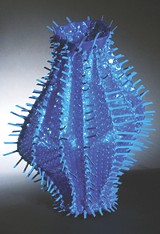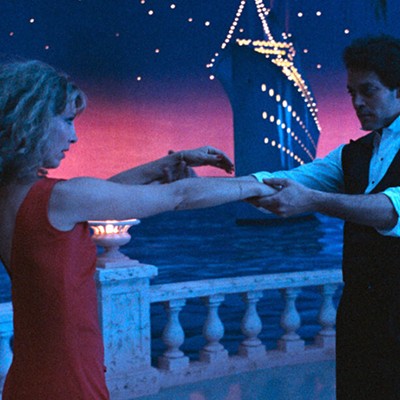[
{
"name": "500x250 Ad",
"insertPoint": "5",
"component": "15667920",
"parentWrapperClass": "",
"requiredCountToDisplay": "1"
}
]
Claire Schneider, curator of the Extreme Abstraction exhibition at the Albright-KnoxArtGallery in Buffalo, recently pointed out that the word "extreme" may be the word of our time. For example, reality TV shows like Fear Factor show "ordinary" people jumping from tall buildings, laying among snakes, and/or eating all sorts of strange things all in the pursuit of being "extreme."
And then there are extreme sports. One of the announcers at this year's Winter Olympics made an interesting observation: if all the new, alternative sporting events are considered "extreme," then what would you call an "old" event like ski-jumping? In that event, participants fly through the air for distances greater than a football field. Isn't that "extreme"?
In the art world, isn't what we know about the art of the 20th century in some way already a form of extremity? Isn't taking an idea or materials to the limits extreme? (Indeed, wasn't collage the first extreme material?) The inclusion of ready-made objects into the process of making art seems already to have opened art up to the possibilities of new and unusual materials. Philosopher Arthur Danto once said that the history of art had ended because everything that could be done had been done. So now, thanks to the ready-made, since anything can be called art and put into the museum, what more can happen?
We already had the extreme variety of materials, and all the shells, minerals, metals and myriad other organic and inorganic materials getting crushed, smashed, ground and combined with oil, egg whites, water, acrylic polymers and what-have-you to make a painting seem like an extreme process. That brings us to the soon-to-be closing exhibition currently at the MemorialArtGallery.
Extreme Materials consists of 42 "non-traditional" works by 35 national and international artists who work with such diverse materials as little drug bags (picked up from the sidewalks in a Brooklyn housing project and turned into a quirky but certainly clever patchwork "quilt" by Tom Fruin) to carrots, orange peels and peach pits, eggshells, bugs, tires, zippers --- even smog and smoke. It's actually quite an impressively creative use of the detritus of everyday life.
But is it all just smoke and mirrors? Well, yes and no. Artists have been transforming all sorts of materials into beautiful objects for a long time now, and many of those included in Extreme Materials are no exception. But what seems to be downplayed in favor of the diversity of materials is the diversity of intentionalities. Although we can maybe get a glimpse of what these artists are interested in through the accompanying didactic statements, in the end what everyone "oohs" and "ahhs" about is still, if only, the transformation of duck sauce packets or garden hoses into art.
There is a good side and a bad side to exhibitions like this. The good thing is that it gets people to go see art. We are all pleasantly surprised and impressed that a bunch of differently colored zippers, tightly coiled one around the other, could get us to envision a sea urchin or perhaps a crystalline cluster of raw amethyst, like Susan Colquitt's Colors in Water: Superior; or that a manipulated scrap of a bright blue plastic pool cover is reminiscent of the soft, slumping sides of an old Native American basket, like Emily Dvorin'sNatatorium Cactus. (Interestingly, Dvorin's sculptural form reminded us of an effect similarly achieved by glass artist Dale Chilhuly back in the 1970s.)
The "problem," however, is that we are also often left with the expectation of the spectacular in art. For art to compete with the rest of our media-saturated world, it has to perform on some extra, ultra, extreme level, and all those things that are quiet and subtle --- things that if we actually take the time to look at and think about would reveal themselves to be just as amazing --- are now lost in the pop and fizzle of pyrotechnics and fanfare of a world caught up in the extreme.
If art is a cultural product that gives us, as a culture, some form of alternative to the rest of the things in the world, then what is the MemorialArtGallery saying by collapsing art into just another spectacle?
Extreme Materials through April 9 | MemorialArtGallery, 500 University Avenue| Gallery hours are Wednesday through Sunday 11 a.m. to 5 p.m., Thursday until 9 p.m., Sunday 1 p.m. to 5 p.m., closed Mondays and Tuesdays. Sunday, April 2, from 11 a.m. to 5 p.m., is "Extreme Sunday" and admission is free. Otherwise admission is $7, $5 for seniors, $5 for students, $2 for children 6-18, free for children under 5. For more info call 473-7720 or visit online at http://mag.rochester.edu
Latest in Art
More by Alex Miokovic
-
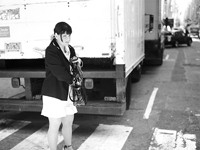
Larry Merrill at M. Early Gallery
Dec 6, 2006 -
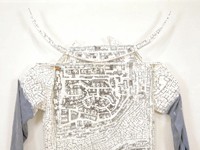
"Kim Jones: A Retrospective"
Nov 29, 2006 -
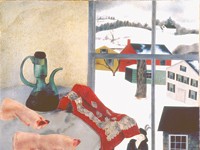
"My America" at the MAG
Nov 8, 2006 - More »
More by Heidi Nickisher
-

Larry Merrill at M. Early Gallery
Dec 6, 2006 -

"Kim Jones: A Retrospective"
Nov 29, 2006 -

"My America" at the MAG
Nov 8, 2006 - More »
